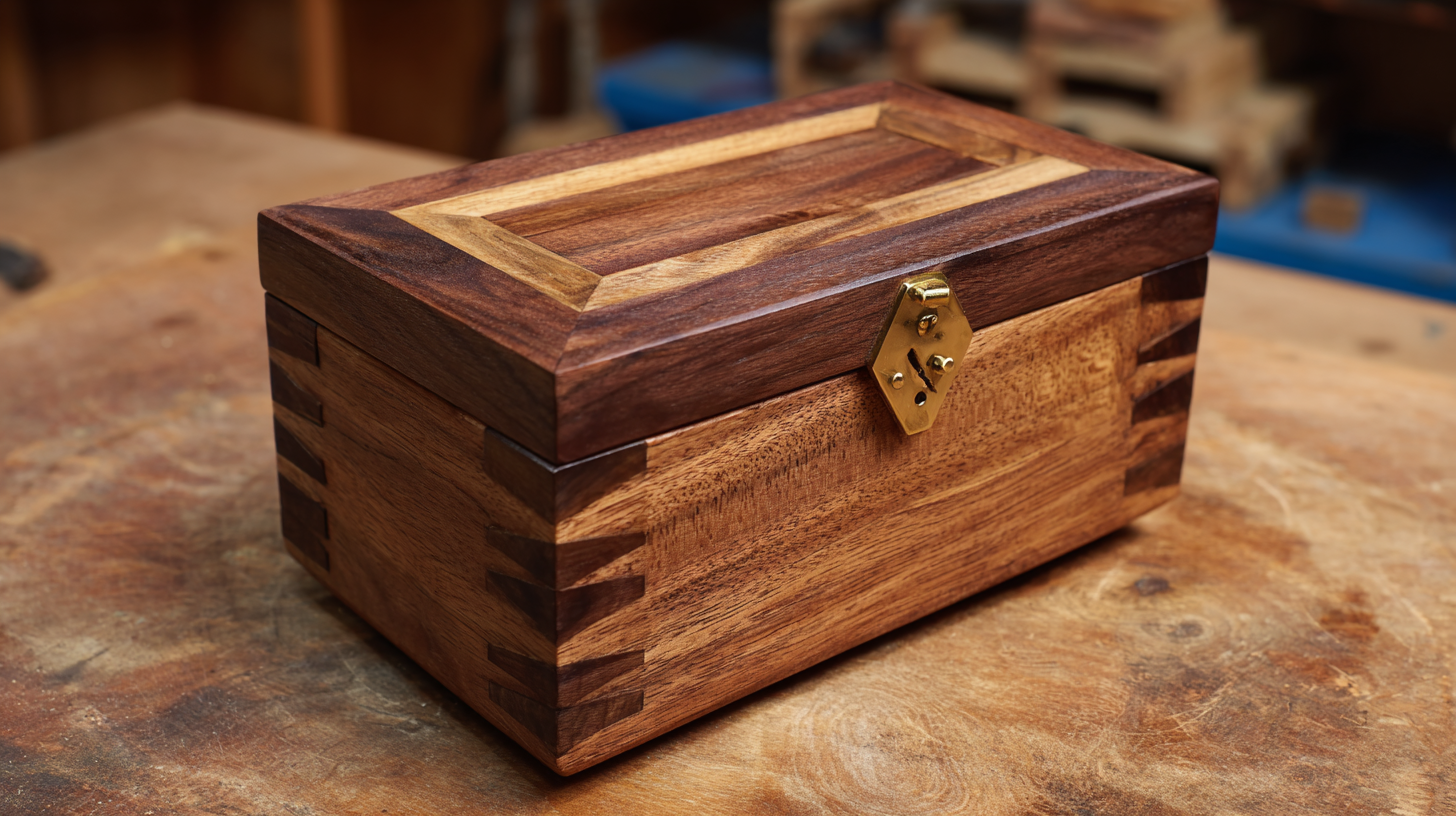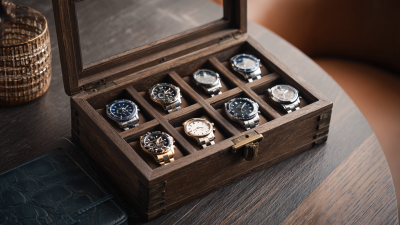In the realm of handcrafted items, the woodworking jewelry box stands out as a quintessential example of artistry and functionality. According to a report by IBISWorld, the woodworking industry has seen a consistent annual growth rate of around 3.5%, with custom woodworking gaining significant traction among consumers seeking unique, personalized products. This trend highlights a shift in consumer preferences towards bespoke items, particularly in the jewelry storage segment, where the demand for custom designs has surged. As individuals increasingly seek to express their personal style, crafting your own woodworking jewelry box becomes not only a creative endeavor but also a reflection of enduring elegance. This ultimate guide will explore the essential aspects of designing and constructing a custom woodworking jewelry box that not only meets practical storage needs but also serves as a striking piece of art.

Custom jewelry boxes play a vital role in personal expression, particularly in an age where individuality is highly valued. As Generation Z emerges, they seek authenticity in the items they choose—preferably products that reflect their unique identities. Custom woodworking jewelry boxes offer an opportunity to express personal stories through thoughtful design and handcrafted elements. According to industry reports, the global gemstones market is projected to reach USD 101.01 billion by 2032, growing at a CAGR of 6.3%. This booming market underscores the importance of personal artifacts like jewelry boxes that not only house precious items but also serve as a canvas for artistic expression.
The rise of custom jewelry boxes comes at a time when consumers are drawn to meaningful keepsakes, emphasizing the emotional connection over mere aesthetics. Each box can be tailored to echo personal memories or significant life events, creating a lasting impression that resonates deeply with users. As creative endeavors serve as forms of therapy, the act of crafting a jewelry box aligns with broader trends favoring handmade and bespoke products—a testament to Generation Z's appreciation for authenticity and craftsmanship in a digitally dominated world. Engaging in such projects allows individuals to curate their stories while making connections to their heritage, ultimately transforming a simple box into a treasured heirloom.
When embarking on the journey of crafting a custom woodworking jewelry box, selecting the right wood is of paramount importance. Different wood species not only influence the aesthetic appeal but also dictate the box's durability and overall feel. According to a report by the Wood Database, hardwoods like walnut and mahogany are popular choices due to their rich colors and fine grain patterns, which contribute to a luxurious look. Walnut, specifically, has been shown to increase in value over time, making it a smart investment for items meant to last a lifetime.
Furthermore, the selection of finishes can elevate your jewelry box from ordinary to extraordinary. A study published in the Journal of the American Woodworking Association reveals that oil-based finishes bring out the natural beauty of the wood, enhancing its grain and depth. On the other hand, high-gloss varnishes offer a modern sheen that can reflect light beautifully, adding a contemporary touch. By understanding the characteristics of various woods and finishes, you can create a jewelry box that is not only functional but also a stunning piece of art that showcases your craftsmanship and personal style.

Creating a custom woodworking jewelry box is not just a craft; it’s an expression of artistry and precision. To embark on this journey, possessing essential tools is crucial. According to the U.S. Bureau of Labor Statistics, the woodworking industry saw a 4% growth from 2019 to 2029, highlighting the increasing interest in custom woodworking projects. A well-equipped workshop typically includes a table saw, miter saw, drill press, and various hand tools like chisels and sanders. These tools not only facilitate the accurate cutting and shaping of wood but also enhance the overall quality of the finished product.
In addition to the right tools, understanding essential techniques is vital for success in crafting a bespoke jewelry box. Joinery methods such as dovetail joints and finger joints add structural strength and visual appeal. A report by the Woodworking Machinery Industry Association states that specialized machinery in woodworking can improve efficiency by 30%, enabling craftsmen to execute intricate designs with precision. Furthermore, mastering finishing techniques, including sanding and applying stains or varnishes, will elevate the aesthetic of your jewelry box, ensuring it is as beautiful as it is functional. Embrace the art of woodworking, and let these tools and techniques guide you in creating a timeless piece.
When designing your custom woodworking jewelry box, the right styles and features can significantly elevate its elegance and functionality. According to a recent market analysis by IBISWorld, the jewelry box manufacturing industry has seen a steady growth rate of 3.5% annually, indicating a rising consumer interest in unique and personalized accessories. Incorporating distinctive design elements such as intricate carvings, inlays, or mixed materials can not only enhance the aesthetic appeal but also reflect the owner’s personal style.

Furthermore, the inclusion of organizational features, suchspan style="text-decoration: underline; color: #FF6347;"> such as customizable compartments and removable trays, plays a significant role in the usability of a jewelry box. The Custom Woodworking Association reports that 70% of consumers prioritize functionality when selecting home decor items. By integrating versatile storage options into your custom design, you can ensure that your jewelry box serves its purpose while remaining an exquisite piece of art. Whether you choose a classic cherry wood finish or go for a modern walnut look, the combination of style and practicality will create a timeless treasure that will be cherished for years to come.
Personalizing a jewelry box can transform it from a simple storage solution into a cherished keepsake. Consider adding intricate designs or meaningful engravings that reflect the recipient’s personality or your shared memories. This could involve using laser cutting techniques to create delicate patterns or incorporating photographs that showcase your relationship. By integrating personal elements, such as dates or initials, you create a unique piece that communicates thoughtfulness and affection.
Another idea for customization is to select materials that resonate with the recipient's style. Whether it’s a rich walnut finish or a vibrant painted exterior, the choice of wood can significantly impact the overall look and feel of the jewelry box. Additionally, incorporating soft velvet or silk linings adds a touch of luxury. Pairing craftsmanship with personal touches not only enhances the aesthetic appeal but also imbues the jewelry box with emotional significance, making it a treasured gift that celebrates special moments and personal connections.
| Feature | Description | Customization Options | Materials | Finishing Techniques |
|---|---|---|---|---|
| Size | Various dimensions available to fit different jewelry types. | Can be tailored to specific measurements or proportions. | Oak, Cherry, Maple, Walnut. | Oil finishing, lacquer, stain options. |
| Compartments | Dual compartments for rings, earrings, and bracelets. | Dividers can be added or removed as needed. | Natural wood vs. painted finishes. | Matte or glossy surface finishes. |
| Lid Design | Hinged or sliding lid for easy access. | Engraving, carved designs, or inlays. | Reclaimed timber, bamboo options. | Burnishing, hand-sanding. |
| Locking Mechanism | Secure storage for valuables. | Choice between traditional locks and modern catches. | Metal or wooden locking systems. | Coating to prevent rust and wear. |






